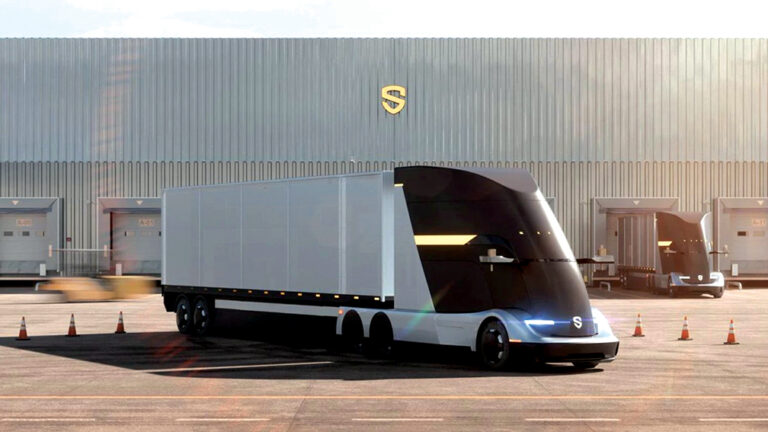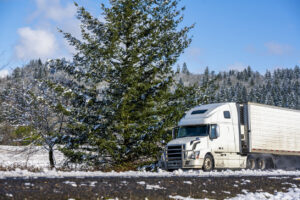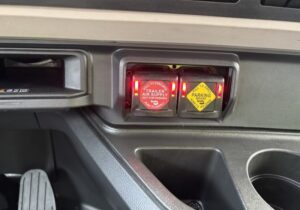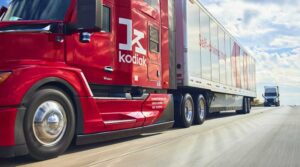Truck brands are so prevalent that even children who spend time on the road learn the familiar names. Freightliner. International. Kenworth. Mack. Peterbilt. Volvo. Western Star. Most drivers can picture the logos for each in their minds. Some can still picture older logos that aren’t in production anymore.
For a while, there was Sterling, too. When Freightliner purchased Ford’s heavy-duty truck line in 1997, the company rebranded Ford’s Aeromax lineup with the Sterling nameplate, featuring a stylish “S” that just happened to be the same dimensions and shape of the old Ford oval.
Soon, however, another truck line may have its own version of the “S” proudly displayed on its front end. Unlike the Sterling, however, nobody will be driving the Solo SD1, slated to be offered by Solo AVT (Advanced Vehicle Technologies) beginning next year.
That’s because the new model tractor will be completely autonomous, with no human on board.
The SD1 combines a battery powered electric drivetrain with other new technology to produce a totally new vehicle design.
“We realized that both building an electric vehicle and building an autonomous vehicle by retrofitting trucks isn’t a way to really usher in the age of electric mobility or autonomy,” said Graham Doorley, founder and CEO of Solo AVT. “We see a future where a new truck, built from the ground up new, is the way to go.”
Current developers of autonomous trucks, including those running freight in Arizona and Texas, are using common truck brands and adding cameras, sensors and computers to control the units electronically. On public highways, drivers are in the cab to take over when safety dictates and to provide feedback from the driver’s perspective of the truck’s performance.
Development of Solo AVT’s new truck — including engineering for the electric drivetrain, drive-by-wire system and the software — is in progress as this story goes to press. The developmental vehicle is expected to transition to production in 2026.
Doorley spoke about some of the other developers of electric vehicles.
“If you have a truck with a frame and an engine in the front, you’re limited as to where you put the batteries and electric motors. The vehicle wasn’t designed for them, so you have to hang batteries from the frame like saddlebags and add motors where you can,” he said.
“So, when you start saying OK, I’m gonna design a vehicle from scratch to be electric now, and that means we have kind of a modular setup where the heart of the truck is essentially a battery on wheels with a truck around it,” he continued.
Doorley and many of the team members at Solo AVT have past experience working on autonomous or electric vehicles at other developers such as Waymo, Tesla or Tu-Simple. Solo AVT, however, is doing things differently. While other builders are focused on building either an electric vehicle or an autonomous one, Solo AVT started with a blank sheet of paper and a desire to combine both concepts in one vehicle.
The Solo AVT website, soloavt.com, features a video in which Eric Canonge, vice president of production and director of engineering, notes, “We are rethinking every facet of the truck: gear meshing, brake design, battery system layout and aerodynamics.” He says the mission of Solo AVT is to build “the safest, cleanest truck ever.”
The company moved into its Fremont, California, headquarters in March 2022.
“That facility was picked due to the high ceilings and high bay doors so we can get trucks inside, but we’re not going to be doing the production there,” Doorley clarified. “That is purely an engineering R&D (research and development) facility. We’ve just actually surpassed 20 employees and continue to grow.”
Solo AVT’s website claims that the SD1 will achieve 500 miles on a single charge. That range will work for local, drayage or short-haul applications where the truck is returned to a facility with a charging station, but the lack of driver equipment and amenities is what makes the range feasible, according to the company.
Power-consuming features like heat and air conditioning aren’t needed in a driverless truck. Inverters won’t be needed to power refrigerators and microwaves. Stereos, dome and bunk lights, and other interior features will be gone.
In addition, equipment that adds weight without using power are gone — no driver’s seat, no bunk, not even a steering wheel or shifter, no dash display. Windshield wipers are unnecessary because there is no windshield.
“This is echoed every day, that every kilowatt matters,” Doorley said. “We really bake it down into: How efficient are we from an aerodynamic perspective? How efficient are our brakes and tires gonna be? What cable sizing can we use to increase efficiency, decrease weight? All of that means less battery, less battery mass, more range.”
There are plans to incorporate some special lighting into the design of the SD1, Doorley said.
“The lighting can be a bit more interesting, right?” he asked. “Let’s say how you would demonstrate to external parties that your intention is turning, stopping, you know, moving forward or whatever.”
While turn signals and brake lights are already commonplace, additional lighting might be necessary so the public knows what that driverless truck is doing. Doorley suggested that the truck might display actual words to alert the public.
Sound is another area being developed, since electric vehicles don’t produce engine noise.
“When you talk about sound, you want it to produce a noise that will alert people that it’s going to be around,” Doorley explained.
Could he be thinking of something like a continuous back-up alarm that simply makes noise to attract the attention of others?
“I can’t give too much away too much, but I can say, be more clever,” he said. “It’s going to be a little bit more elegant. You’ll hear a nicer sound. It’s not like an engine sound or alarm sound, but it just notifies people that it’s around and that it’s moving.”
When the SD1 goes into production, expected for the second half of 2023, you won’t find one for sale on a dealer’s lot, however.
“We’re actually going to be doing trucking as a service,” Doorley said.
Rather than selling SD1s, the company will lease them out to carriers along with support systems such as Information Technology and maintenance.
No one knows exactly what trucking will look like in 50 years, but Doorley doesn’t see trucks with drivers going away. However, he is excited about the trucking niche that autonomous trucks will fill without adding carbon to the environment.
Cliff Abbott is an experienced commercial vehicle driver and owner-operator who still holds a CDL in his home state of Alabama. In nearly 40 years in trucking, he’s been an instructor and trainer and has managed safety and recruiting operations for several carriers. Having never lost his love of the road, Cliff has written a book and hundreds of songs and has been writing for The Trucker for more than a decade.














